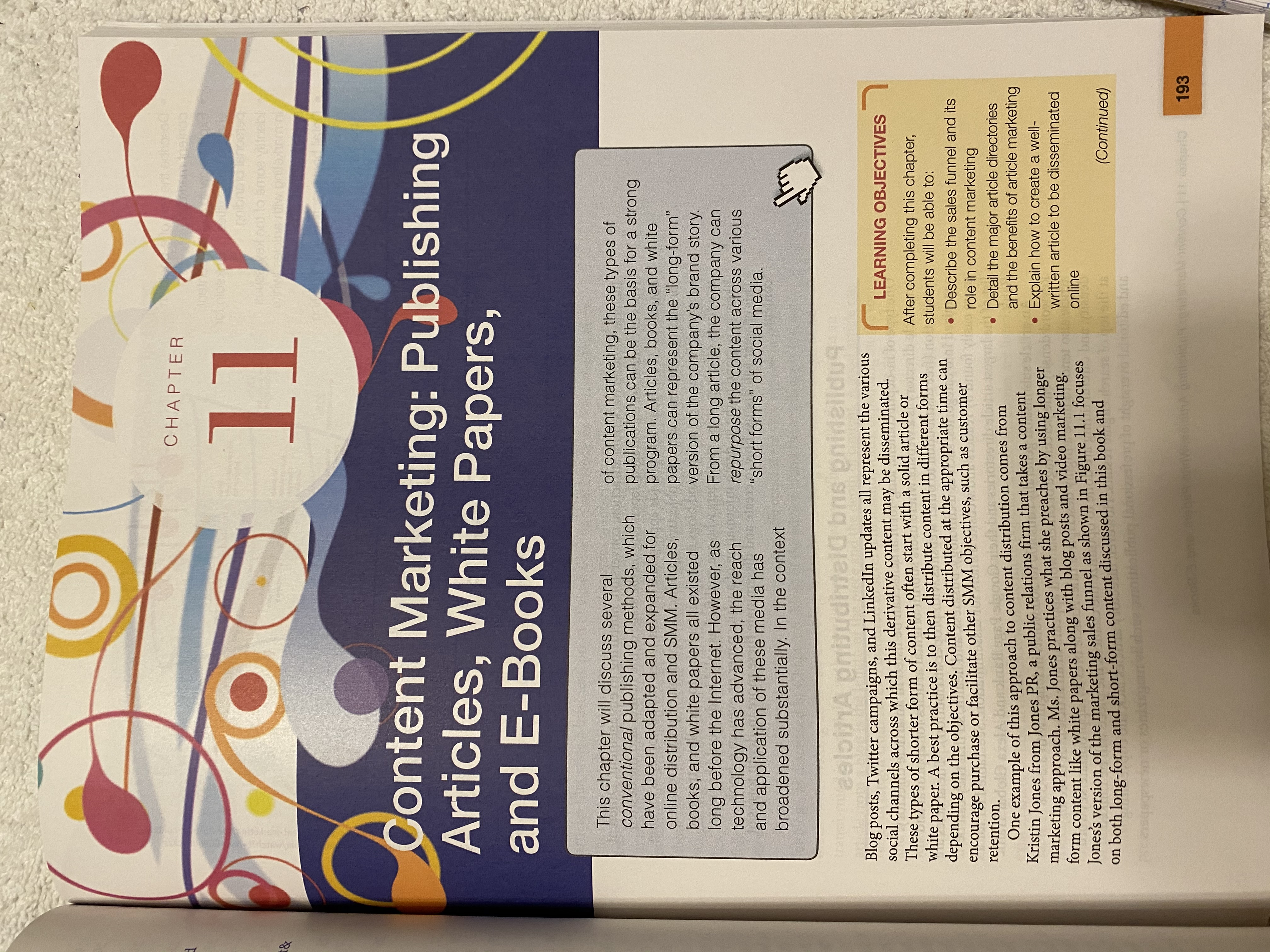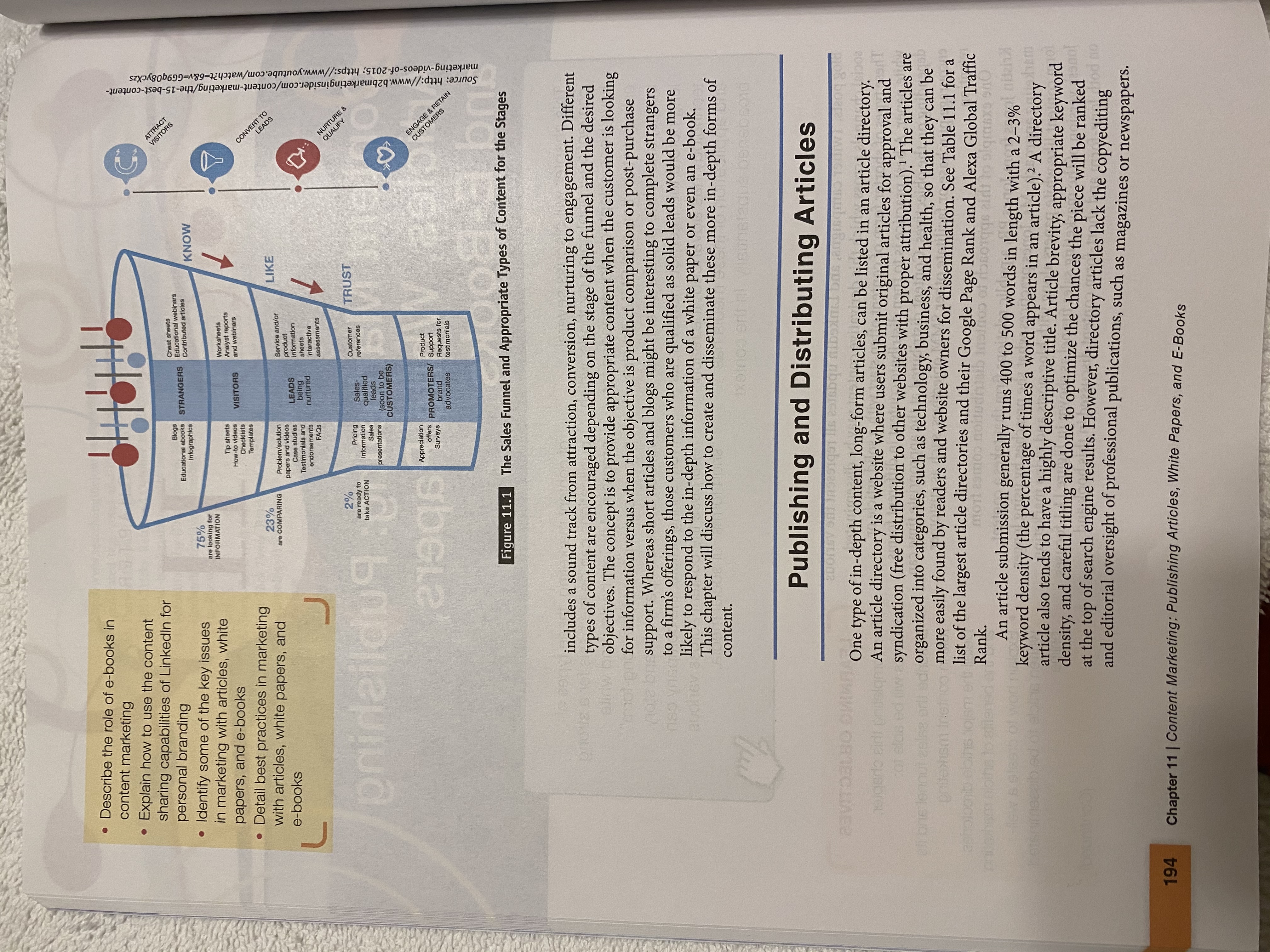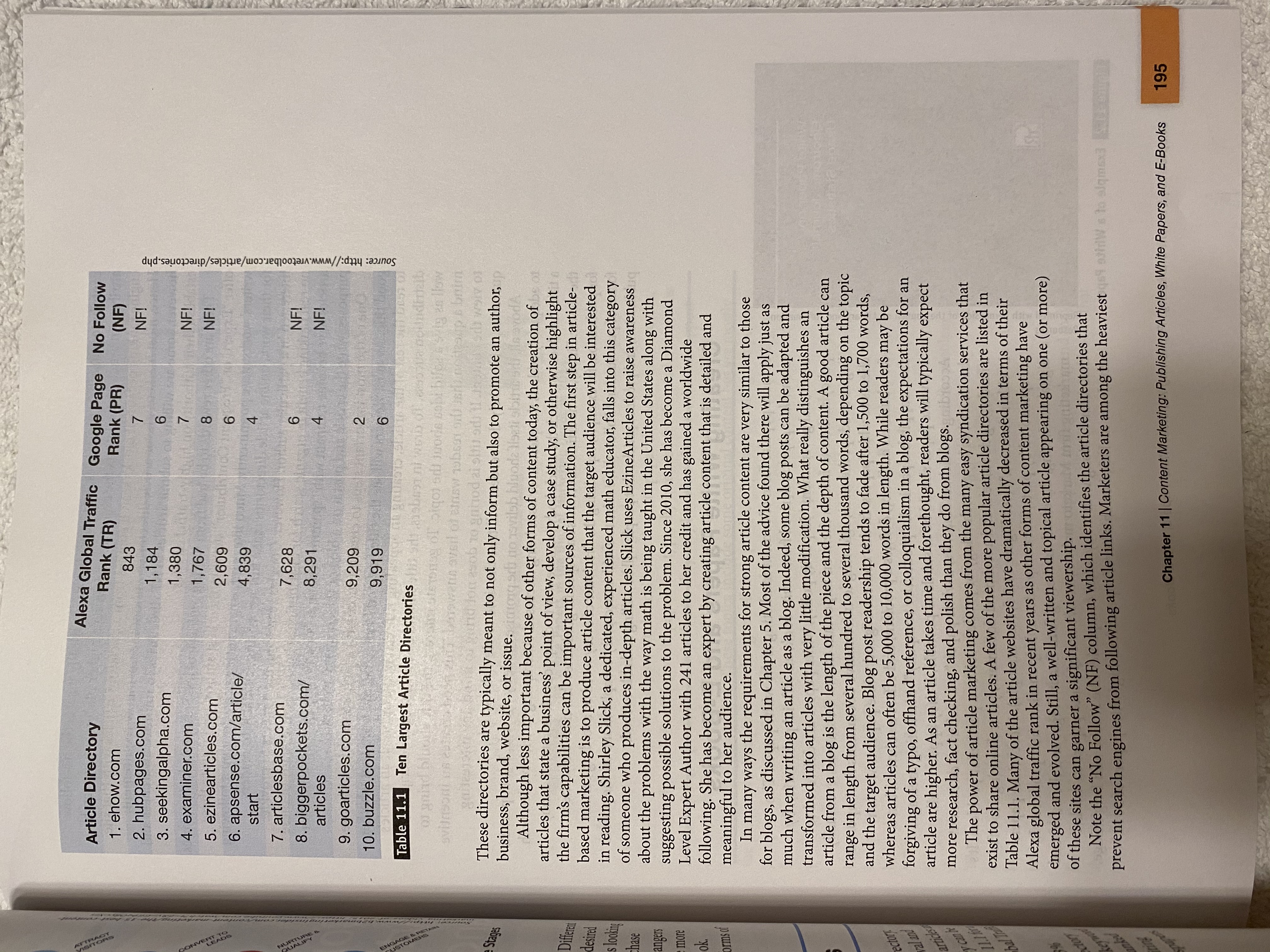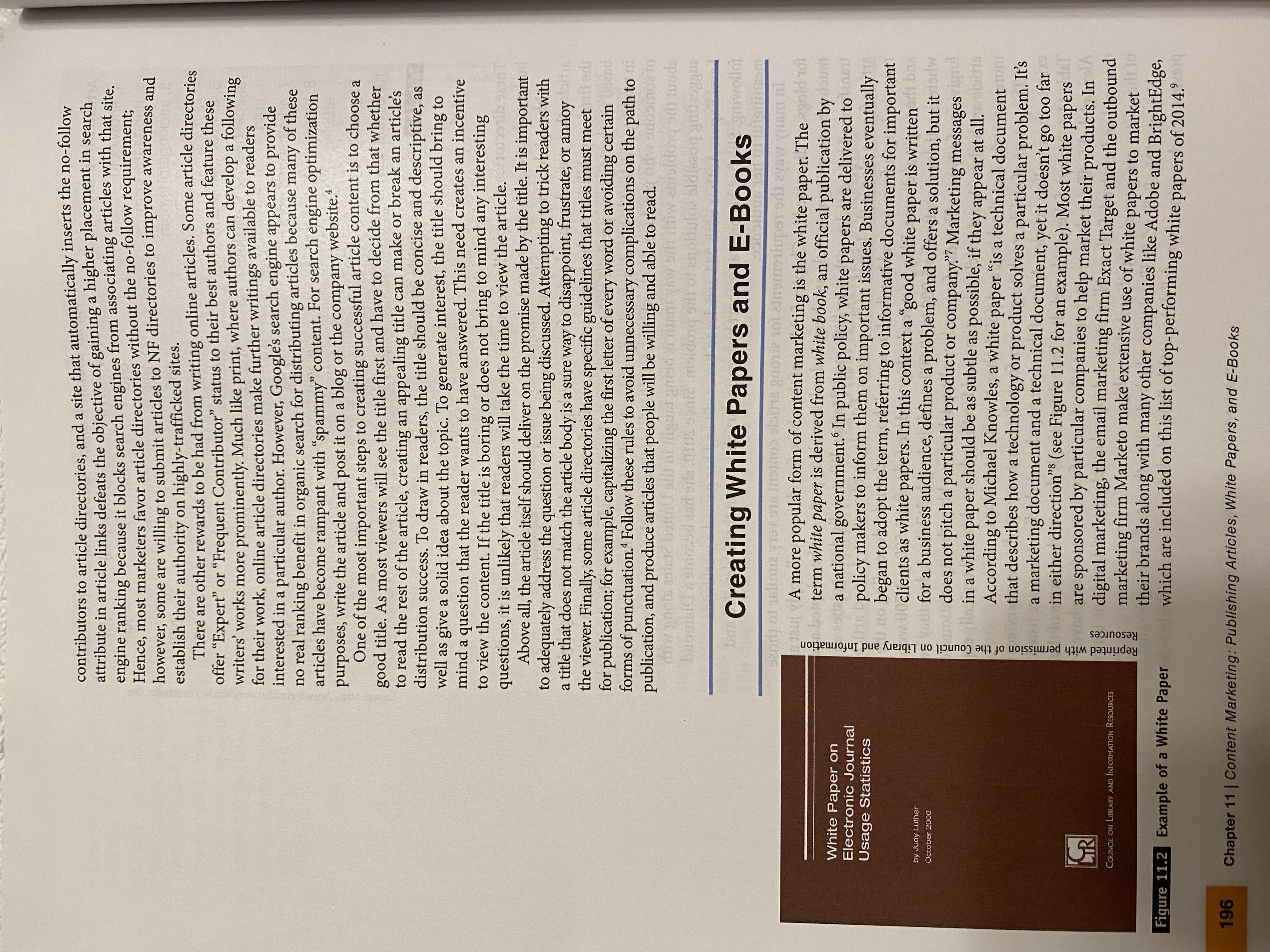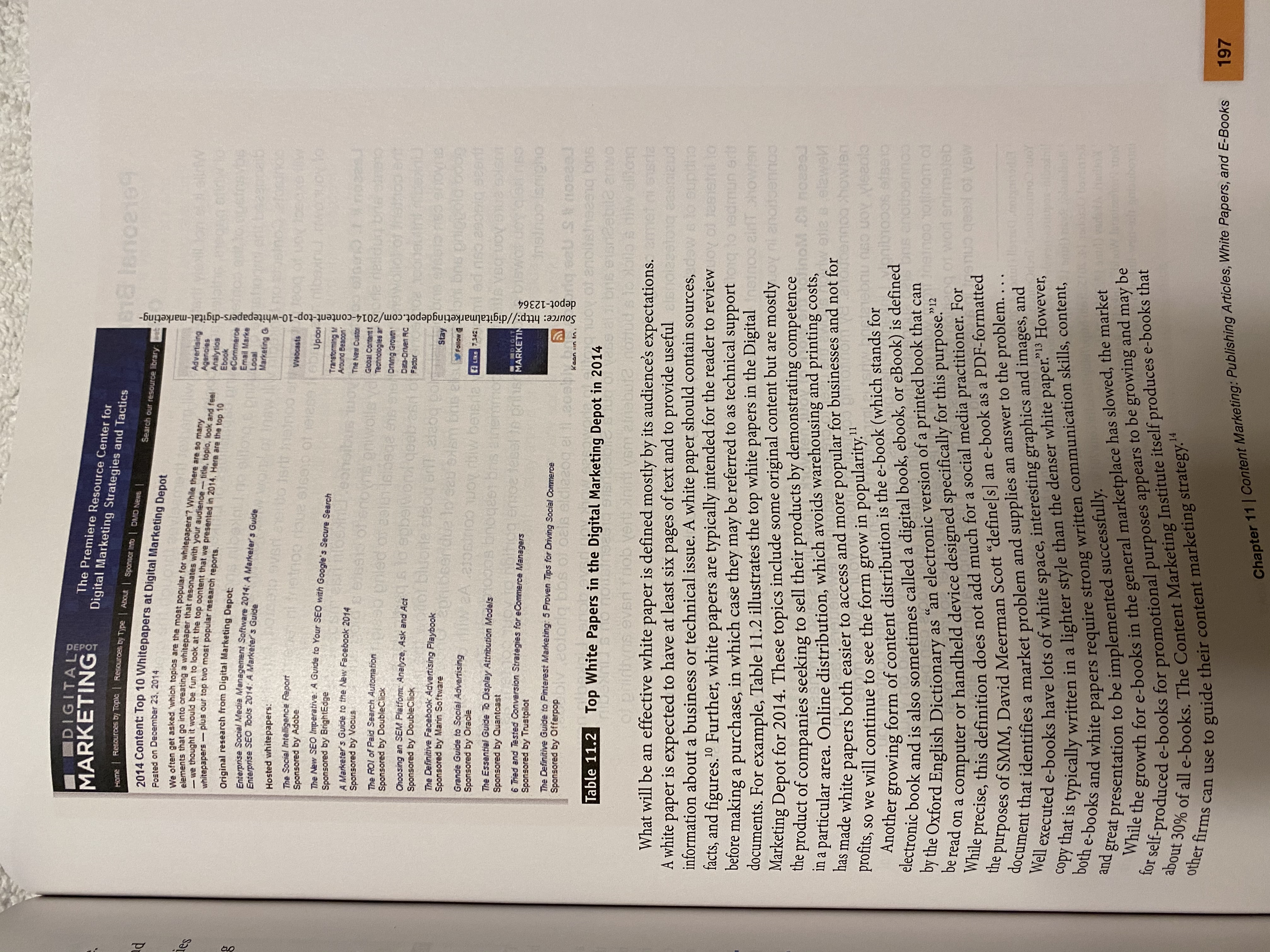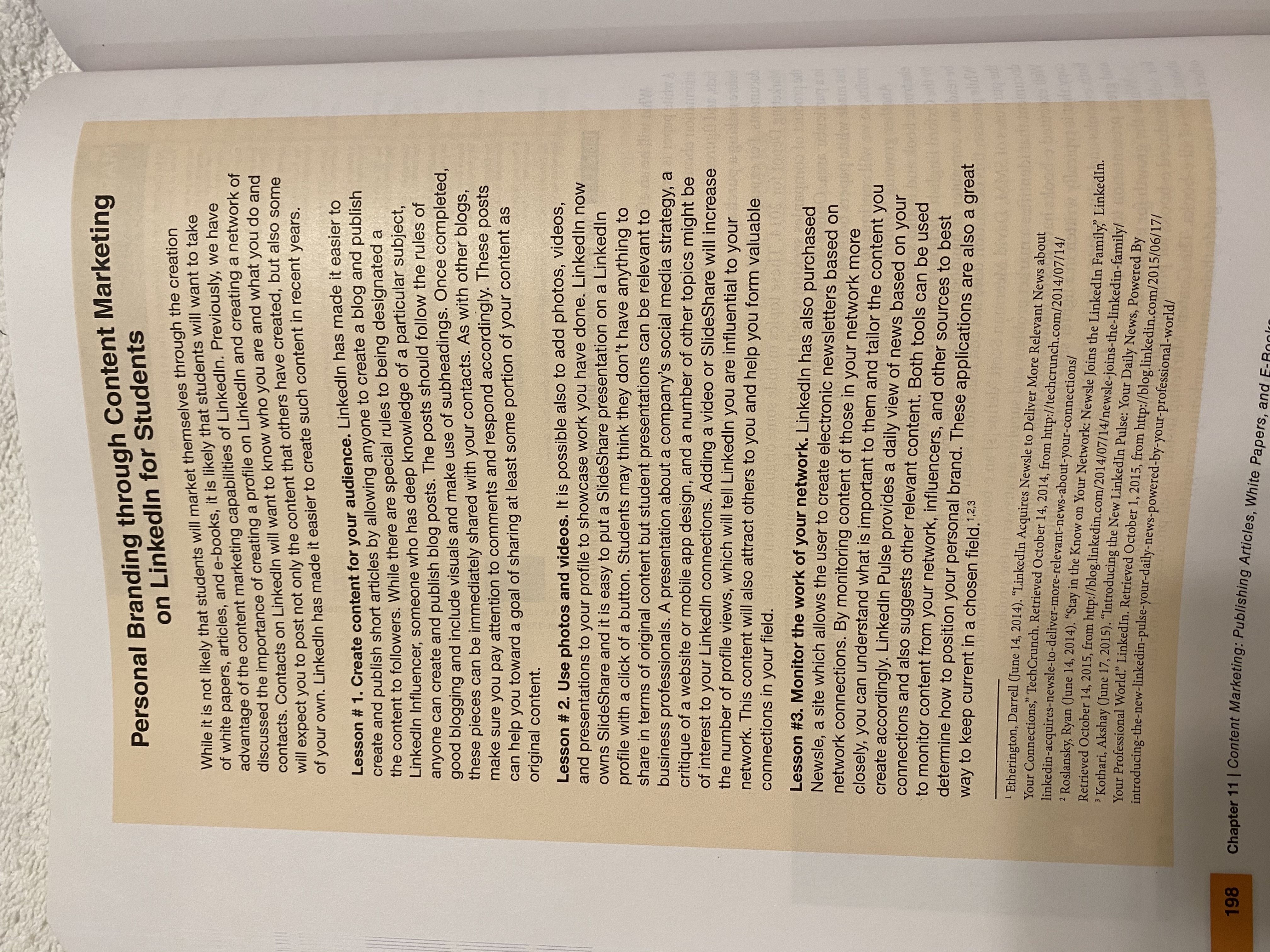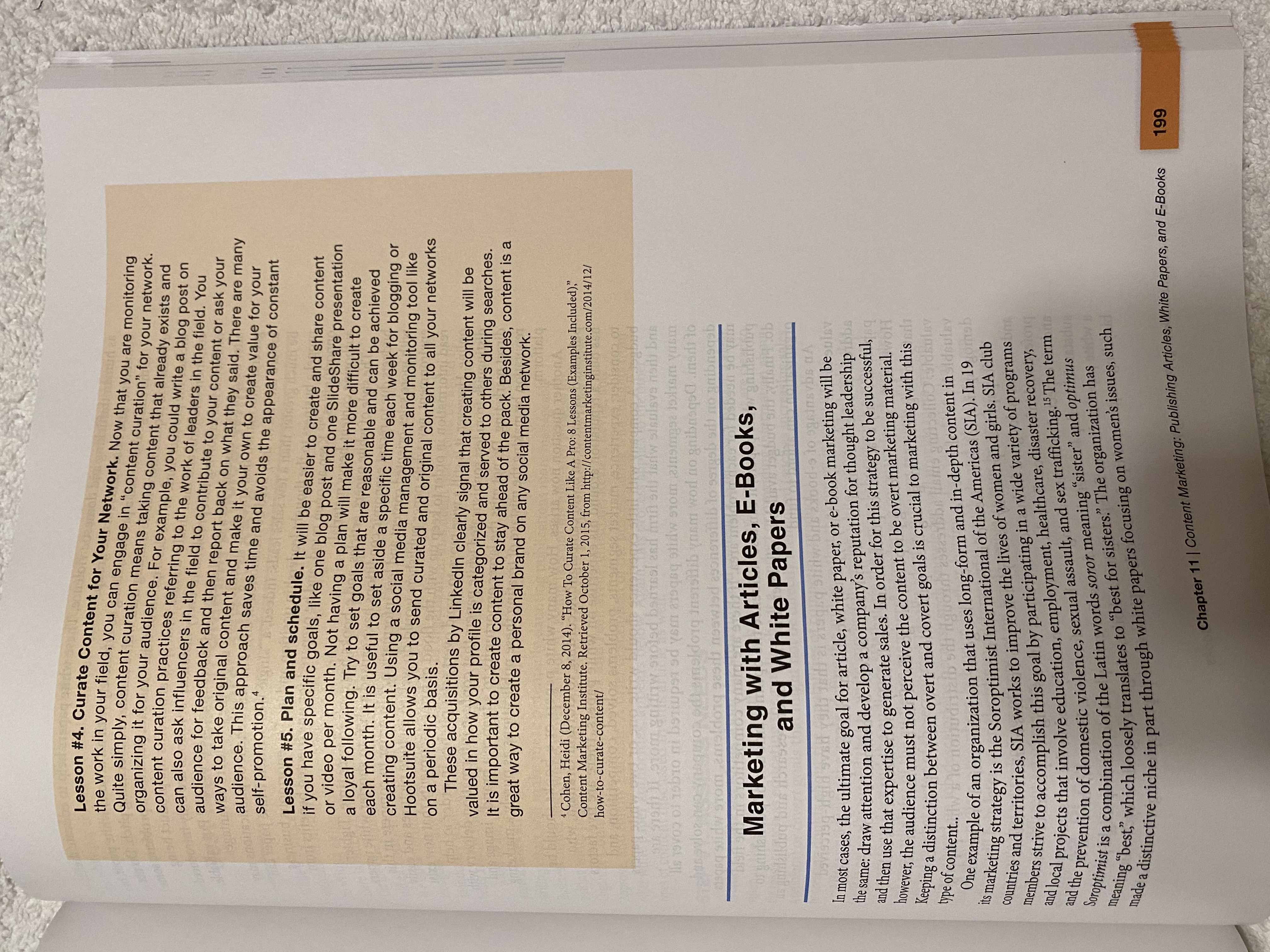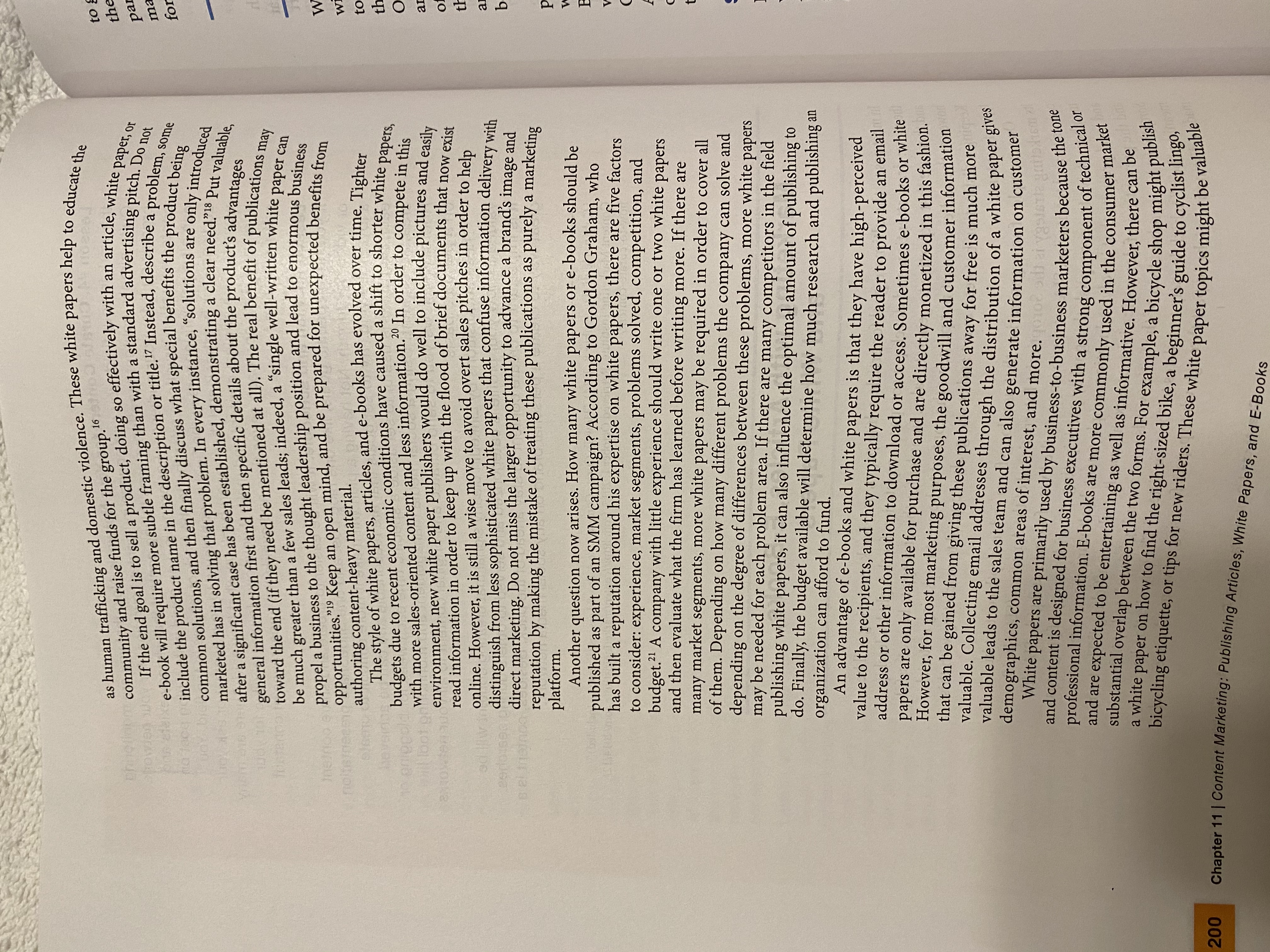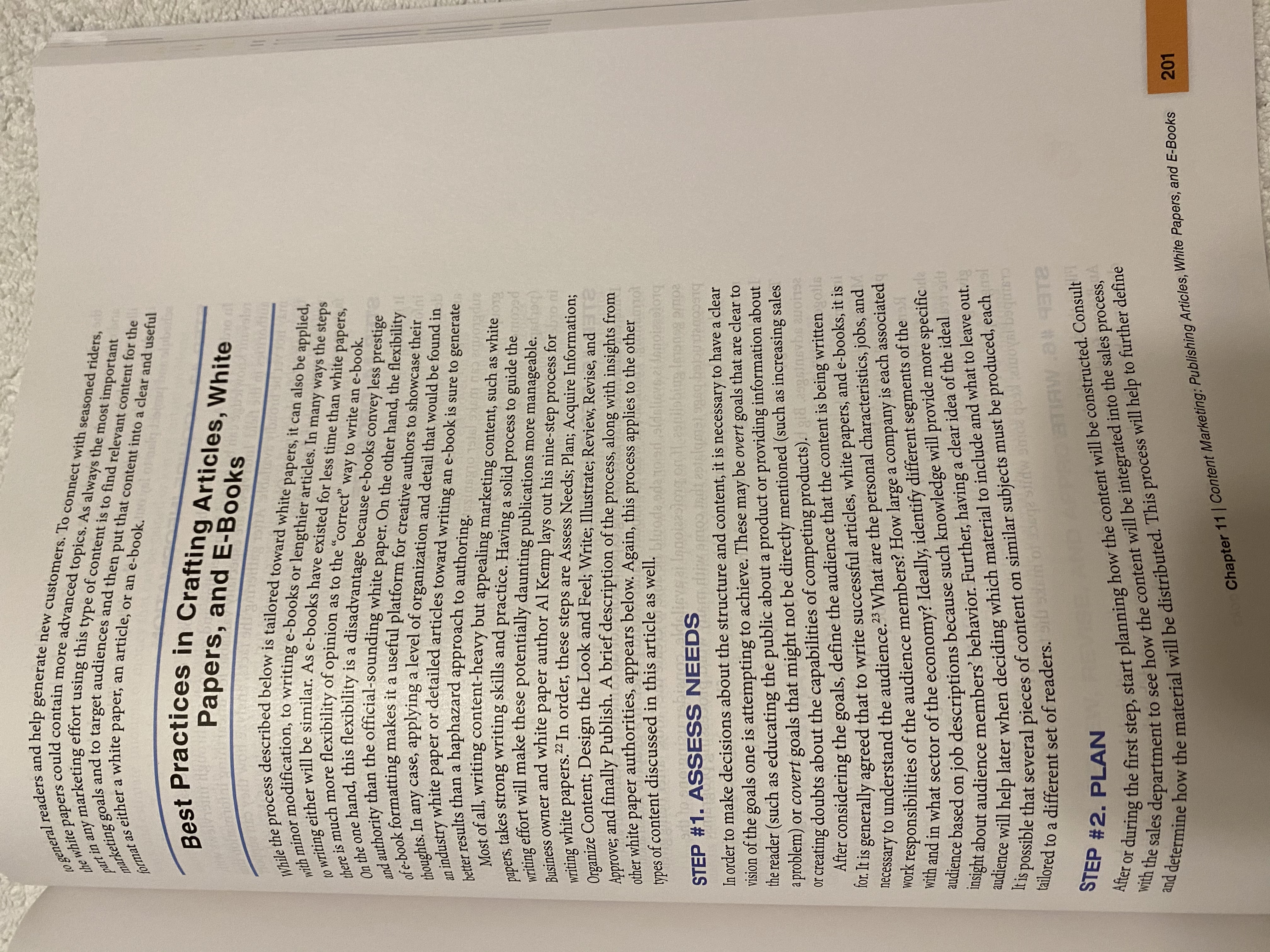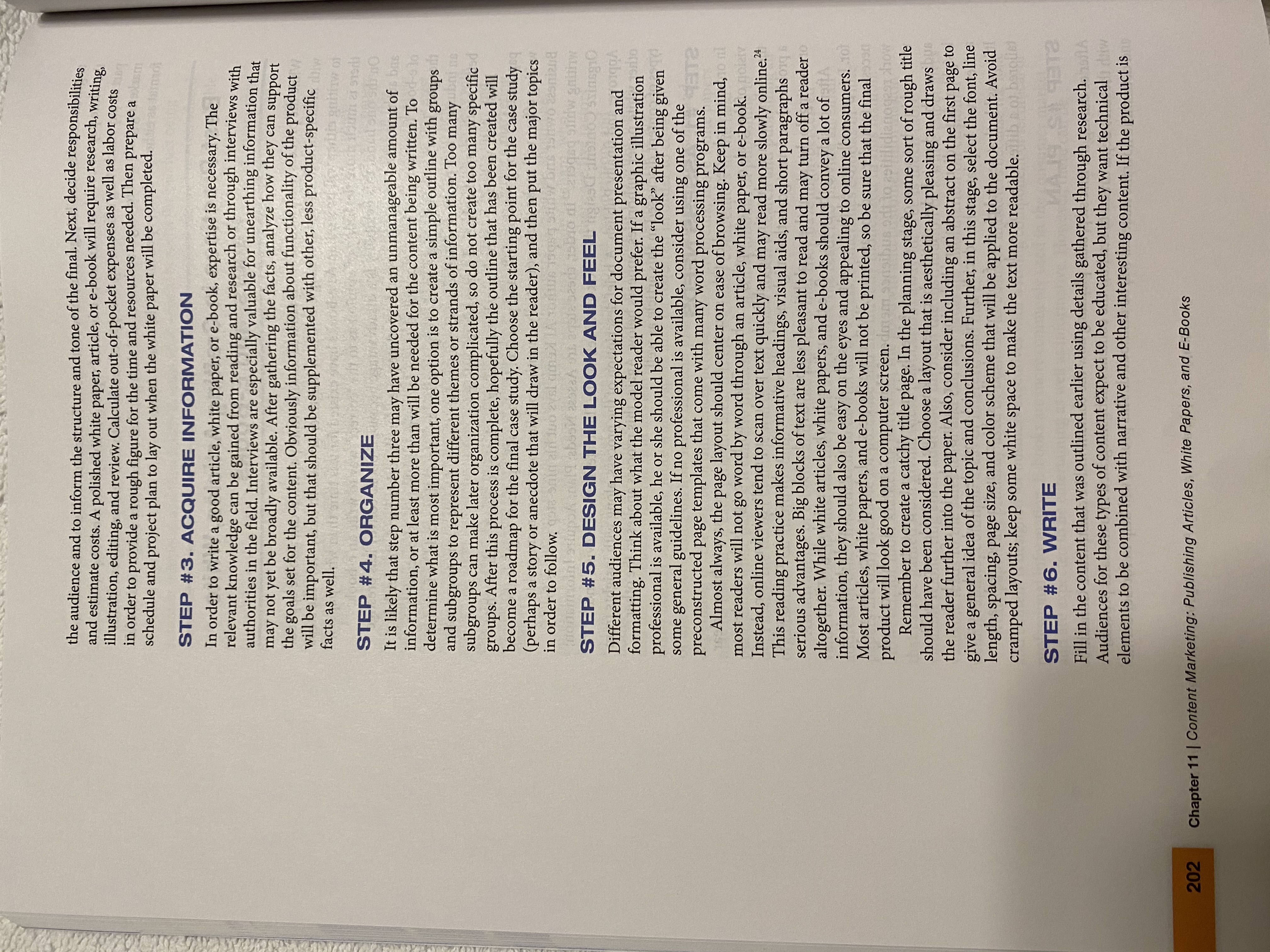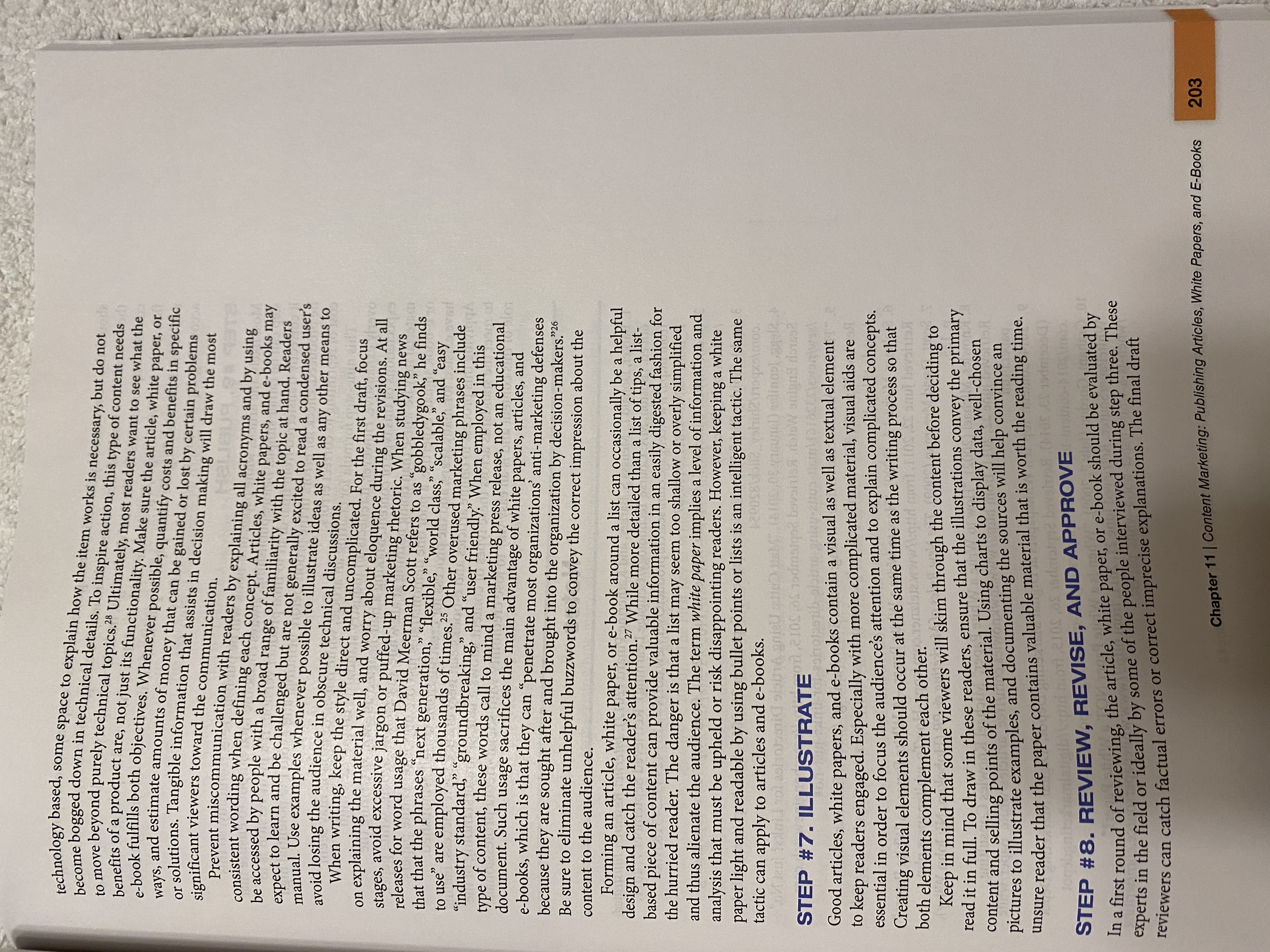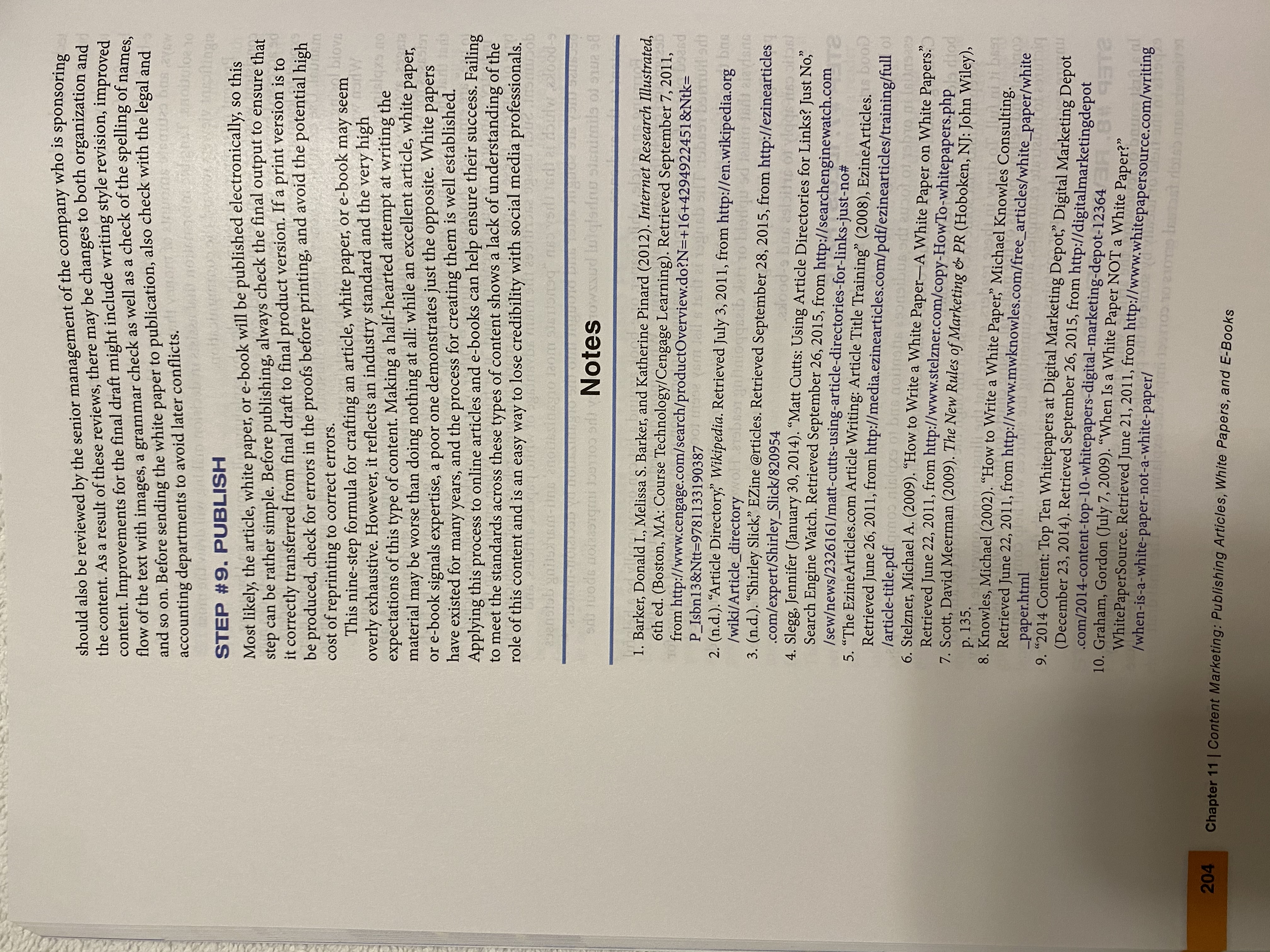CHAPTER 11 Content Marketing: Publishing Articles, White Papers, and E-Books This chapter will discuss several of content marketing, these types of conventional publishing methods, which publications can be the basis for a strong have been adapted and expanded for program. Articles, books, and white online distribution and SMM. Articles, papers can represent the "long-form" books, and white papers all existed version of the company's brand story. long before the Internet. However, as From a long article, the company can technology has advanced, the reach repurpose the content across various and application of these media has "short forms" of social media. broadened substantially. In the context coloinA oniJudiweld bris prindalldug Blog posts, Twitter campaigns, and LinkedIn updates all represent the various social channels across which this derivative content may be disseminated. LEARNING OBJECTIVES These types of shorter form of content often start with a solid article or After completing this chapter, white paper. A best practice is to then distribute content in different forms students will be able to: depending on the objectives. Content distributed at the appropriate time can . Describe the sales funnel and its encourage purchase or facilitate other SMM objectives, such as customer role in content marketing retention. . Detail the major article directories One example of this approach to content distribution comes from and the benefits of article marketing Kristin Jones from Jones PR, a public relations firm that takes a content Explain how to create a well- marketing approach. Ms. Jones practices what she preaches by using longer written article to be disseminated form content like white papers along with blog posts and video marketing. online Jones's version of the marketing sales funnel as shown in Figure 1 1.1 focuses on both long-form and short-form content discussed in this book and "Continued) 193. Describe the role of e-books in content marketing . Explain how to use the content ATTRACT VISITORS sharing capabilities of Linkedin for Cheat sheets personal branding Educational ebooks STRANGERS contributed articles Infographics KNOW . Identify some of the key issues in marketing with articles, white INFORMATION Worksheets Hip sheets Analyst reports papers, and e-books checklists VISITORS and webinars Templates CONVERT TO . Detail best practices in marketing LEADS 23% LIKE with articles, white papers, and are COMPARING Problem/solution Service and/or papers and video product LEADS information Source: http://www. b2bmarketinginsider.com/content-marketing/the-15-best-content- e-books Testimonials and being sheets marketing-videos-of-2015; https://www.youtube.com/watch?t=6&v=GG9q08ycXzs endorsements nurtured interactive assessments NURTURE 8 270 Custom TRUST prideildug a ready to Pricing references take ACTION nformation qualified presentations (soon to be CUSTOMERS) ENGAGE Appreciation Product Surveys PROMOTERS/ Support CUSTOMERS Requests for advocates testimonials RETAIN Figure 11.1 The Sales Funnel and Appropriate Types of Content for the Stages includes a sound track from attraction, conversion, nurturing to engagement. Different types of content are encouraged depending on the stage of the funnel and the desired objectives. The concept is to provide appropriate content when the customer is looking for information versus when the objective is product comparison or post-purchase support. Whereas short articles and blogs might be interesting to complete strangers to a firm's offerings, those customers who are qualified as solid leads would be more aughey likely to respond to the in-depth information of a white paper or even an e-book. This chapter will discuss how to create and disseminate these more in-depth forms of content. Visunslacus Publishing and Distributing Articles One type of in-depth content, long-form articles, can be listed in an article directory. An article directory is a website where users submit original articles for approval and of elus ed live syndication (free distribution to other websites with proper attribution).' The articles are llore lernut zelse orto organized into categories, such as technology, business, and health, so that they can be Onileshem fretheo more easily found by readers and website owners for dissemination. See Table 11.1 for a list of the largest article directories and their Google Page Rank and Alexa Global Traffic Rank. An article submission generally runs 400 to 500 words in length with a 2-3% keyword density (the percentage of times a word appears in an article). A directory article also tends to have a highly descriptive title. Article brevity, appropriate keyword density, and careful titling are done to optimize the chances the piece will be ranked at the top of search engine results. However, directory articles lack the copyediting d no and editorial oversight of professional publications, such as magazines or newspapers. 194 Chapter 11 | Content Marketing: Publishing Articles, White Papers, and E-BooksArticle Directory Alexa Global Traffic Google Page Rank (TR) No Follow 1. ehow.com Rank (PR) (NF) 343 2. hubpages.com NF! 1, 184 3. seekingalpha.com 1,380 4. examiner.com 7 NF! 1,767 8 5. ezinearticles.com NF! 2,609 6 6. apsense.com/article/ 4,839 start Source: http://www.vretoolbar.com/articles/directories.php 7. articlesbase.com 7,628 6 NF! 8. biggerpockets.com/ 8,291 articles 4 NF! 9. goarticles.com 9,209 2 10. buzzle.com 9,919 6 Table 11.1 Ten Largest Article Directories fores of bigot adi moods sopt bilve s sly andlow Stages These directories are typically meant to not only inform but also to promote an author, business, brand, website, or issue. Although less important because of other forms of content today, the creation of articles that state a business point of view, develop a case study, or otherwise highlight Different the firm's capabilities can be important sources of information. The first step in article- desired based marketing is to produce article content that the target audience will be interested s looking in reading. Shirley Slick, a dedicated, experienced math educator, falls into this category hase of someone who produces in-depth articles. Slick uses Ezine Articles to raise awareness about the problems with the way math is being taught in the United States along with angers suggesting possible solutions to the problem. Since 2010, she has become a Diamond more Level Expert Author with 241 articles to her credit and has gained a worldwide ok. following. She has become an expert by creating article content that is detailed and orms of meaningful to her audience. In many ways the requirements for strong article content are very similar to those for blogs, as discussed in Chapter 5. Most of the advice found there will apply just as much when writing an article as a blog. Indeed, some blog posts can be adapted and transformed into articles with very little modification. What really distinguishes an article from a blog is the length of the piece and the depth of content. A good article can range in length from several hundred to several thousand words, depending on the topic and the target audience. Blog post readership tends to fade after 1,500 to 1,700 words, whereas articles can often be 5,000 to 10,000 words in length. While readers may be forgiving of a typo, offhand reference, or colloquialism in a blog, the expectations for an article are higher. As an article takes time and forethought, readers will typically expect more research, fact checking, and polish than they do from blogs. The power of article marketing comes from the many easy syndication services that exist to share online articles. A few of the more popular article directories are listed in Table 11.1. Many of the article websites have dramatically decreased in terms of their Alexa global traffic rank in recent years as other forms of content marketing have She emerged and evolved. Still, a well-written and topical article appearing on one (or more) of these sites can garner a significant viewership. Note the "No Follow" (NF) column, which identifies the article directories that prevent search engines from following article links. Marketers are among the heaviest W s to sigmanspeak Chapter 11 | Content Marketing: Publishing Articles, White Papers, and E-Books 195contributors to article directories, and a site that automatically inserts the no-follow attribute in article links defeats the objective of gaining a higher placement in search engine ranking because it blocks search engines from associating articles with that site. Hence, most marketers favor article directories without the no-follow requirement; however, some are willing to submit articles to NF directories to improve awareness and establish their authority on highly-trafficked sites. There are other rewards to be had from writing online articles. Some article directories offer "Expert" or "Frequent Contributor" status to their best authors and feature these writers' works more prominently. Much like print, where authors can develop a following for their work, online article directories make further writings available to readers interested in a particular author. However, Google's search engine appears to provide no real ranking benefit in organic search for distributing articles because many of these articles have become rampant with "spammy" content. For search engine optimization purposes, write the article and post it on a blog or the company website. One of the most important steps to creating successful article content is to choose a good title. As most viewers will see the title first and have to decide from that whether to read the rest of the article, creating an appealing title can make or break an article's distribution success. To draw in readers, the title should be concise and descriptive, as well as give a solid idea about the topic. To generate interest, the title should bring to mind a question that the reader wants to have answered. This need creates an incentive to view the content. If the title is boring or does not bring to mind any interesting questions, it is unlikely that readers will take the time to view the article. Above all, the article itself should deliver on the promise made by the title. It is important to adequately address the question or issue being discussed. Attempting to trick readers with a title that does not match the article body is a sure way to disappoint, frustrate, or annoy the viewer. Finally, some article directories have specific guidelines that titles must meet ed for publication; for example, capitalizing the first letter of every word or avoiding certain forms of punctuation.* Follow these rules to avoid unnecessary complications on the path to publication, and produce articles that people will be willing and able to read. entsldong sth mods buoriel & smooed aorderfa .OrOS sonia tofluids bidleeon aniJesague Creating White Papers and E-Books gniwollot A more popular form of content marketing is the white paper. The gold tol White Paper on term white paper is derived from white book, an official publication by Electronic Journal a national government. In public policy, white papers are delivered to Usage Statistics policy makers to inform them on important issues. Businesses eventually began to adopt the term, referring to informative documents for important by Judy Luther clients as white papers. In this context a "good white paper is written October 2000 for a business audience, defines a problem, and offers a solution, but it sw does not pitch a particular product or company." Marketing messages Reprinted with permission of the Council on Library and Information in a white paper should be as subtle as possible, if they appear at all. According to Michael Knowles, a white paper "is a technical document to that describes how a technology or product solves a particular problem. It's a marketing document and a technical document, yet it doesn't go too far in either directions (see Figure 1 1.2 for an example). Most white papers TR are sponsored by particular companies to help market their products. In COUNCIL ON LIBRARY AND INFORMATION RESOURCES digital marketing, the email marketing firm Exact Target and the outbound Resources marketing firm Marketo make extensive use of white papers to market Figure 11.2 Example of a White Paper their brands along with many other companies like Adobe and BrightEdge, which are included on this list of top-performing white papers of 2014.' 196 Chapter 11 | Content Marketing: Publishing Articles, White Papers, and E-BooksDIGITAL MARKETING: The Premiere Resource Center for Home | Resources by Topic | Resources by Type Digital Marketing Strategies and Tactics About | Sponsor Into | DMD News | 18 lance169 2014 Content: Top 10 Whitepapers at Digital Marketing Depot Posted on December 23, 2014 Search our resource library: al-marketing We often get asked which topics are the most popular for whitepapers"? While there are so many elements that go into creating a whitepaper that resonates with your audience - title, topio, look and feel Advertising - we thought it would be fun to look at the top content that we presented in 2014. Here are the top 10 whitepapers - plus our top two most popular research reports. Agencies Analytion Original research from Digital Marketing Depot: Enterprise Social Media Management Software 2014: A Marketer's Guide Email Marke is 2014: A Marketer's Guide Marketing G Hosted whitepapers: The Social Intelligence Report ento felt mainoo Sponsored by Adobe Webcasts ca of way losake The New SEO Imperative. A Guide to Your SEO with Google's Secure Search Upcor Sponsored by BrightEdge Transforming M A Marketer's Guide to the New Facebook 2014 Around Beacon' Sponsored by Vocus The ROI of Paid Search Automation elbais oftenowns eniwolle v The New Custo Global Content 1 Sponsored by DoubleClick an unled or eblunt lelosge gets Technologies Driving Growth ot.com/ Choosing an SEM Platform: Analyze, Ask and Act carl Data-Driven RC Sponsored by DoubleClick Factor The Definitive Facebook Advertising Playbook Sponsored by Marin Software Stay Grande Guide to Social Advertising Follow e - one onetolo poon Sponsored by Oracle CA etoninos wov rhiw betterleff uke 73421 digitalmarket The Essential Guide To Display Attribution Models Sponsored by Quantcast 6 Tried and Tested Conversion Strategies for eCommerce Managers Hepel in Drills MARKETIN Sponsored by Trustpilot The Definitive Guide to Pinterest Marketing: 5 Proven Tips for Driving Social Commerce Source: http sponsored by Offerpop inn in . Table 11.2 Top White Papers in the Digital Marketing Depot in 2014 of enolisingesng bris bis elbreebile aro What will be an effective white paper is defined mostly by its audience's expectations. amet al exsde A white paper is expected to have at least six pages of text and to provide useful Big casnieud information about a business or technical issue. A white paper should contain sources, facts, and figures. Further, white papers are typically intended for the reader to review Joy of register to before making a purchase, in which case they may be referred to as technical support big to redmun er documents. For example, Table 11.2 illustrates the top white papers in the Digital Binoo aint showten Marketing Depot for 2014. These topics include some original content but are mostly ov pianoifcanned the product of companies seeking to sell their products by demonstrating competence noM .Oil noses! in a particular area. Online distribution, which avoids warehousing and printing costs, ofle Bolewell has made white papers both easier to access and more popular for businesses and not for connoo howian profits, so we will continue to see the form grow in popularity." Another growing form of content distribution is the e-book (which stands for nibigoos atseta electronic book and is also sometimes called a digital book, ebook, or eBook) is defined he enosannos by the Oxford English Dictionary as "an electronic version of a printed book that can inoo 10Nfrom of be read on a computer or handheld device designed specifically for this purpose."12 of work animeleb While precise, this definition does not add much for a social media practitioner. For no qeey of Yaw the purposes of SMM, David Meerman Scott "define[s] an e-book as a PDF-formatted cument that identifies a market problem and supplies an answer to the problem. ... Well executed e-books have lots of white space, interesting graphics and images, and body that is typically written in a lighter style than the denser white paper."'s However, both e-books and white papers require strong written communication skills, content, and great presentation to be implemented successfully. for While the growth for e-books in the general marketplace has slowed, the market or self-produced e-books for promotional purposes appears to be growing and may be about 30% of all e-books. The Content Marketing Institute itself produces e-books that other firms can use to guide their content marketing strategy. 14 Chapter 11 | Content Marketing: Publishing Articles, White Papers, and E-Books 197Personal Branding through Content Marketing on Linkedin for Students While it is not likely that students will market themselves through the creation of white papers, articles, and e-books, it is likely that students will want to take advantage of the content marketing capabilities of Linkedin. Previously, we have discussed the importance of creating a profile on Linkedin and creating a network of contacts. Contacts on Linkedin will want to know who you are and what you do and will expect you to post not only the content that others have created, but also some of your own. Linkedin has made it easier to create such content in recent years. Lesson # 1. Create content for your audience. Linkedin has made it easier to create and publish short articles by allowing anyone to create a blog and publish the content to followers. While there are special rules to being designated a LinkedIn Influencer, someone who has deep knowledge of a particular subject, anyone can create and publish blog posts. The posts should follow the rules of good blogging and include visuals and make use of subheadings. Once completed, these pieces can be immediately shared with your contacts. As with other blogs, make sure you pay attention to comments and respond accordingly. These posts can help you toward a goal of sharing at least some portion of your content as original content. Lesson # 2. Use photos and videos. It is possible also to add photos, videos, and presentations to your profile to showcase work you have done. Linkedin now owns SlideShare and it is easy to put a SlideShare presentation on a Linkedin profile with a click of a button. Students may think they don't have anything to share in terms of original content but student presentations can be relevant to business professionals. A presentation about a company's social media strategy, a critique of a website or mobile app design, and a number of other topics might be of interest to your Linkedin connections. Adding a video or SlideShare will increase the number of profile views, which will tell Linkedin you are influential to your network. This content will also attract others to you and help you form valuable connections in your field. Lesson #3. Monitor the work of your network. Linkedin has also purchased Newsle, a site which allows the user to create electronic newsletters based on network connections. By monitoring content of those in your network more closely, you can understand what is important to them and tailor the content you create accordingly. Linkedin Pulse provides a daily view of news based on your connections and also suggests other relevant content. Both tools can be used to monitor content from your network, influencers, and other sources to best determine how to position your personal brand. These applications are also a great way to keep current in a chosen field. 1,2,3 Etherington, Darrell (June 14, 2014). "LinkedIn Acquires Newsle to Deliver More Relevant News about Your Connections," TechCrunch. Retrieved October 14, 2014, from http://techcrunch.com/2014/07/14/ linkedin-acquires-newsle-to-deliver-more-relevant-news-about-your-connections/ Roslansky, Ryan (June 14, 2014). "Stay in the Know on Your Network: Newsle Joins the LinkedIn Family," LinkedIn. Retrieved October 14, 2015, from http://blog.linkedin.com/2014/07/14ewsle-joins-the-linkedin-family/ Kothari, Akshay (June 17, 2015). "Introducing the New LinkedIn Pulse: Your Daily News, Powered By Your Professional World." LinkedIn. Retrieved October 1, 2015, from http://blog.linkedin.com/2015/06/17/ introducing-the-new-linkedin-pulse-your-daily-news-powered-by-your-professional-world/ 198 Chapter 11 | Content Marketing: Publishing Articles, White Papers, andLesson #4. Curate Content for Your Network. Now that you are monitoring the work in your field, you can engage in "content curation" for your network. Quite simply, content curation means taking content that already exists and organizing it for your audience. For example, you could write a blog post on content curation practices referring to the work of leaders in the field. You can also ask influencers in the field to contribute to your content or ask your audience for feedback and then report back on what they said. There are many ways to take original content and make it your own to create value for your audience. This approach saves time and avoids the appearance of constant self-promotion. 4 Lesson #5. Plan and schedule. It will be easier to create and share content if you have specific goals, like one blog post and one SlideShare presentation or video per month. Not having a plan will make it more difficult to create a loyal following. Try to set goals that are reasonable and can be achieved each month. It is useful to set aside a specific time each week for blogging or creating content. Using a social media management and monitoring tool like Hootsuite allows you to send curated and original content to all your networks on a periodic basis. These acquisitions by Linkedin clearly signal that creating content will be valued in how your profile is categorized and served to others during searches. It is important to create content to stay ahead of the pack. Besides, content is a great way to create a personal brand on any social media network. Cohen, Heidi (December 8, 2014). "How To Curate Content Like A Pro: 8 Lessons (Examples Included)," Content Marketing Institute. Retrieved October 1, 2015, from http://contentmarketinginstitute.com/2014/12/ how-to-curate-content/ sisulava nord bas Marketing with Articles, E-Books, and White Papers In most cases, the ultimate goal for article, white paper, or e-book marketing will be lay the same: draw attention and develop a company's reputation for thought leadership nd then use that expertise to generate sales. In order for this strategy to be successful, however, the audience must not perceive the content to be overt marketing material. keeping a distinction between overt and covert goals is crucial to marketing with this lobulay type of content.. is one example of an organization that uses long-form and in-depth content in drulay is marketing strategy is the Soroptimist International of the Americas (SIA). In 19 countries and territories, SIA works to improve the lives of women and girls. SIA club members strive to accomplish this goal by participating in a wide variety of programs and cal projects that involve education, employment, healthcare, disaster recovery, the prevention of domestic violence, sexual assault, and sex trafficking,t's The term "oroptimist is a combination of the Latin words soror meaning "sister" and optimus meaning "best" which loosely translates to "best for sisters." The organization has made a distinctive niche in part through white papers focusing on women's issues, such 199 Chapter 11 | Content Marketing: Publishing Articles, White Papers, and E-Booksas human trafficking and domestic violence. These white papers help to educate the to community and raise funds for the group. 16 If the end goal is to sell a product, doing so effectively with an article, white the e-book will require more subtle framing than with a standard advertising pitch. Do not par include the product name in the description or title." Instead, describe a problem, some ma for common solutions, and then finally discuss what special benefits the product being marketed has in solving that problem. In every instance, "solutions are only introduced after a significant case has been established, demonstrating a clear need,18 Put valuable general information first and then specific details about the product's advantages toward the end (if they need be mentioned at all). The real benefit of publications may be much greater than a few sales leads; indeed, a "single well-written white paper can propel a business to the thought leadership position and lead to enormous business opportunities."19 Keep an open mind, and be prepared for unexpected benefits from authoring content-heavy material. The style of white papers, articles, and e-books has evolved over time. Tighter budgets due to recent economic conditions have caused a shift to shorter white papers, with more sales-oriented content and less information." In order to compete in this environment, new white paper publishers would do well to include pictures and easily read information in order to keep up with the flood of brief documents that now exist online. However, it is still a wise move to avoid overt sales pitches in order to help distinguish from less sophisticated white papers that confuse information delivery with direct marketing. Do not miss the larger opportunity to advance a brand's image and reputation by making the mistake of treating these publications as purely a marketing platform. Another question now arises. How many white papers or e-books should be published as part of an SMM campaign? According to Gordon Graham, who has built a reputation around his expertise on white papers, there are five factors to consider: experience, market segments, problems solved, competition, and budget.21 A company with little experience should write one or two white papers and then evaluate what the firm has learned before writing more. If there are many market segments, more white papers may be required in order to cover all of them. Depending on how many different problems the company can solve and depending on the degree of differences between these problems, more white papers may be needed for each problem area. If there are many competitors in the field publishing white papers, it can also influence the optimal amount of publishing to do. Finally, the budget available will determine how much research and publishing an organization can afford to fund. An advantage of e-books and white papers is that they have high-perceived value to the recipients, and they typically require the reader to provide an email address or other information to download or access. Sometimes e-books or white papers are only available for purchase and are directly monetized in this fashion. However, for most marketing purposes, the goodwill and customer information that can be gained from giving these publications away for free is much more valuable. Collecting email addresses through the distribution of a white paper gives valuable leads to the sales team and can also generate information on customer demographics, common areas of interest, and more. White papers are primarily used by business-to-business marketers because the tone and content is designed for business executives with a strong component of technical of professional information. E-books are more commonly used in the consumer market and are expected to be entertaining as well as informative. However, there can be substantial overlap between the two forms. For example, a bicycle shop might publish a white paper on how to find the right-sized bike, a beginner's guide to cyclist lingo, bicycling etiquette, or tips for new riders. These white paper topics might be valuable 200 Chapter 11 | Content Marketing: Publishing Articles, White Papers, and E-Booksgeneral readers any help generate new customers. To connect with seasoned riders 10 Bwhite papers could contain more advanced topics. As always the most important the in any marketing effort using this type of content is to find relevant content for the Parketing goals and to target audiences and then put that content into a clear and useful format as either a white paper, an article, or an e-book. Best Practices in Crafting Articles, White Papers, and E-Books While the process described below is tailored toward white papers, it can also be applied, with minor modification, to writing e-books or lengthier articles. In many ways the steps to writing either will be similar. As e-books have existed for less time than white papers, there is much more flexibility of opinion as to the "correct" way to write an e-book. on the one hand, this flexibility is a disadvantage because e-books convey less prestige and authority than the official-sounding white paper. On the other hand, the flexibility ofe-book formatting makes it a useful platform for creative authors to showcase their thoughts. In any case, applying a level of organization and detail that would be found in an industry white paper or detailed articles toward writing an e-book is sure to generate better results than a haphazard approach to authoring. Most of all, writing content-heavy but appealing marketing content, such as white papers, takes strong writing skills and practice. Having a solid process to guide the writing effort will make these potentially daunting publications more manageable. Business owner and white paper author Al Kemp lays out his nine-step process for writing white papers."In order, these steps are Assess Needs; Plan; Acquire Information; Organize Content; Design the Look and Feel; Write; Illustrate; Review, Revise, and Approve; and finally Publish. A brief description of the process, along with insights from other white paper authorities, appears below. Again, this process applies to the other ypes of content discussed in this article as well. bode pdanger aldstays al donoin story STEP #1. ASSESS NEEDS In order to make decisions about the structure and content, it is necessary to have a clear vision of the goals one is attempting to achieve. These may be overt goals that are clear to he reader (such as educating the public about a product or providing information about a problem) or covert goals that might not be directly mentioned (such as increasing sales or creating doubts about the capabilities of competing products). After considering the goals, define the audience that the content is being written tolls for. It is generally agreed that to write successful articles, white papers, and e-books, it is necessary to understand the audience.23 What are the personal characteristics, jobs, and work responsibilities of the audience members? How large a company is each associated with and in what sector of the economy? Ideally, identify different segments of the audience based on job descriptions because such knowledge will provide more specific insight about audience members' behavior. Further, having a clear idea of the ideal audience will help later when deciding which material to include and what to leave out. It is possible that several pieces of content on similar subjects must be produced, each tailored to a different set of readers. STEP #2. PLAN After or during the first step, start planning how the content will be constructed. Consult at to see how the content will be integrated into the sales process, with the sales department to see and determine how the material will be distributed. This process will help to further define 201 Chapter 11 | Content Marketing: Publishing Articles, White Papers, and E-Booksthe audience and to inform the structure and tone of the final. Next, decide responsibilities and estimate costs. A polished white paper, article, or e-book will require research, writing. illustration, editing, and review. Calculate out-of-pocket expenses as well as labor costs in order to provide a rough figure for the time and resources needed. Then prepare a schedule and project plan to lay out when the white paper will be completed. STEP #3. ACQUIRE INFORMATION In order to write a good article, white paper, or e-book, expertise is necessary. The relevant knowledge can be gained from reading and research or through interviews with authorities in the field. Interviews are especially valuable for unearthing information that may not yet be broadly available. After gathering the facts, analyze how they can support the goals set for the content. Obviously information about functionality of the product will be important, but that should be supplemented with other, less product-specific facts as well. How of STEP #4. ORGANIZE It is likely that step number three may have uncovered an unmanageable amount of bus information, or at least more than will be needed for the content being written. To determine what is most important, one option is to create a simple outline with groups and subgroups to represent different themes or strands of information. Too many subgroups can make later organization complicated, so do not create too many specific groups. After this process is complete, hopefully the outline that has been created will become a roadmap for the final case study. Choose the starting point for the case study (perhaps a story or anecdote that will draw in the reader), and then put the major topics in order to follow. STEP #5. DESIGN THE LOOK AND FEEL 09 swinggio Different audiences may have varying expectations for document presentation and formatting. Think about what the model reader would prefer. If a graphic illustration professional is available, he or she should be able to create the "look" after being given some general guidelines. If no professional is available, consider using one of the preconstructed page templates that come with many word processing programs. aTe Almost always, the page layout should center on ease of browsing. Keep in mind, most readers will not go word by word through an article, white paper, or e-book. Instead, online viewers tend to scan over text quickly and may read more slowly online.24 This reading practice makes informative headings, visual aids, and short paragraphs serious advantages. Big blocks of text are less pleasant to read and may turn off a reader altogether. While white articles, white papers, and e-books should convey a lot of information, they should also be easy on the eyes and appealing to online consumers. To Most articles, white papers, and e-books will not be printed, so be sure that the final product will look good on a computer screen. Remember to create a catchy title page. In the planning stage, some sort of rough title should have been considered. Choose a layout that is aesthetically pleasing and draws the reader further into the paper. Also, consider including an abstract on the first page to give a general idea of the topic and conclusions. Further, in this stage, select the font, line length, spacing, page size, and color scheme that will be applied to the document. Avoid cramped layouts; keep some white space to make the text more readable. STEP #6. WRITE Fill in the content that was outlined earlier using details gathered through research. Audiences for these types of content expect to be educated, but they want technicaly elements to be combined with narrative and other interesting content. If the product is 202 Chapter 11 | Content Marketing: Publishing Articles, White Papers, and E-Bookstechnology based, some space to explain how the item works is necessary, but do not become bogged down in technical details. To inspire action, this type of content needs to move beyond purely technical topics.28 Ultimately, most readers want to see what the benefits of a product are, not just its functionality. Make sure the article, white paper, or e-book fulfills both objectives. Whenever possible, quantify costs and benefits in specific ways, and estimate amounts of money that can be gained or lost by certain problems or solutions. Tangible information that assists in decision making will draw the most significant viewers toward the communication. Prevent miscommunication with readers by explaining all acronyms and by using consistent wording when defining each concept. Articles, white papers, and e-books may be accessed by people with a broad range of familiarity with the topic at hand. Readers expect to learn and be challenged but are not generally excited to read a condensed user's manual. Use examples whenever possible to illustrate ideas as well as any other means to avoid losing the audience in obscure technical discussions. When writing, keep the style direct and uncomplicated. For the first draft, focus on explaining the material well, and worry about eloquence during the revisions. At all stages, avoid excessive jargon or puffed-up marketing rhetoric. When studying news releases for word usage that David Meerman Scott refers to as "gobbledygook," he finds that that the phrases "next generation," "flexible," "world class," "scalable," and "easy to use" are employed thousands of times.25 Other overused marketing phrases include "industry standard," "groundbreaking" and "user friendly." When employed in this type of content, these words call to mind a marketing press release, not an educational document. Such usage sacrifices the main advantage of white papers, articles, and e-books, which is that they can "penetrate most organizations' anti-marketing defenses because they are sought after and brought into the organization by decision-makers."26 Be sure to eliminate unhelpful buzzwords to convey the correct impression about the content to the audience. Forming an article, white paper, or e-book around a list can occasionally be a helpful design and catch the reader's attention.27 While more detailed than a list of tips, a list- based piece of content can provide valuable information in an easily digested fashion for the hurried reader. The danger is that a list may seem too shallow or overly simplified and thus alienate the audience. The term white paper implies a level of information and analysis that must be upheld or risk disappointing readers. However, keeping a white paper light and readable by using bullet points or lists is an intelligent tactic. The same tactic can apply to articles and e-books. STEP #7. ILLUSTRATE Good articles, white papers, and e-books contain a visual as well as textual element to keep readers engaged. Especially with more complicated material, visual aids are essential in order to focus the audience's attention and to explain complicated concepts. Creating visual elements should occur at the same time as the writing process so that both elements complement each other. Keep in mind that some viewers will skim through the content before deciding to read it in full. To draw in these readers, ensure that the illustrations convey the primary content and selling points of the material. Using charts to display data, well-chosen Pictures to illustrate examples, and documenting the sources will help convince an unsure reader that the paper contains valuable material that is worth the reading time. STEP #8. REVIEW, REVISE, AND APPROVE In a first round of reviewing, the article, white paper, or e-book should be evaluated by experts in the field or ideally by some of the people interviewed during step three. These reviewers can catch factual errors or correct imprecise explanations. The final draft 203 Chapter 11 | Content Marketing: Publishing Articles, White Papers, and E-Booksshould also be reviewed by the senior management of the company who is sponsoring the content. As a result of these reviews, there may be changes to both organization and content. Improvements for the final draft might include writing style revision, improved flow of the text with images, a grammar check as well as a check of the spelling of names, and so on. Before sending the white paper to publication, also check with the legal and EYEW accounting departments to avoid later conflicts. STEP #9. PUBLISH Most likely, the article, white paper, or e-book will be published electronically, so this step can be rather simple. Before publishing, always check the final output to ensure that it correctly transferred from final draft to final product version. If a print version is to be produced, check for errors in the proofs before printing, and avoid the potential high cost of reprinting to correct errors. DIOVA This nine-step formula for crafting an article, white paper, or e-book may seem overly exhaustive. However, it reflects an industry standard and the very high expectations of this type of content. Making a half-hearted attempt at writing the material may be worse than doing nothing at all: while an excellent article, white paper, or e-book signals expertise, a poor one demonstrates just the opposite. White papers have existed for many years, and the process for creating them is well established. Applying this process to online articles and e-books can help ensure their success. Failing to meet the standards across these types of content shows a lack of understanding of the role of this content and is an easy way to lose credibility with social media professionals. nes side ted et doulw ablood- Notes ww lutglaring stanimile of sina ed 1. Barker, Donald I., Melissa S. Barker, and Katherine Pinard (2012). Internet Research Illustrated, 6th ed. (Boston, MA: Course Technology/Cengage Learning). Retrieved September 7, 2011, from http://www.cengage.com/search/productOverview.do?N=+16+4294922451&Ntk= P_Isbn13&Ntt=9781133190387 2. (n.d.). "Article Directory," Wikipedia. Retrieved July 3, 2011, from http://en.wikipedia.org /wiki/ Article_directory wol 3. (n.d.). "Shirley Slick," EZine @rticles. Retrieved September 28, 2015, from http://ezinearticles .com/expert/Shirley_Slick/820954 4. Slegg, Jennifer (January 30, 2014). "Matt Cutts: Using Article Directories for Links? Just No, Search Engine Watch. Retrieved September 26, 2015, from http://searchenginewatch.com /sewews/2326161/matt-cutts-using-article-directories-for-links-just-no# 5. "The EzineArticles.com Article Writing: Article Title Training" (2008), EzineArticles. Retrieved June 26, 2011, from http://media.ezinearticles.com/pdf/ezinearticles/training/full /article-title.pdfm 6. Stelzner, Michael A. (2009). "How to Write a White Paper-A White Paper on White Papers. Retrieved June 22, 2011, from http://www.stelzer.com/copy-HowTo-whitepapers.php 7. Scott, David Meerman (2009). The New Rules of Marketing & PR (Hoboken, NJ: John Wiley), P. 135. 8. Knowles, Michael (2002). "How to Write a White Paper," Michael Knowles Consulting. _paper.html Retrieved June 22, 2011, from http://www.mwknowles.com/free_articles/white_paper/white 9. "2014 Content: Top Ten Whitepapers at Digital Marketing Depot," Digital Marketing Depot (December 23, 2014). Retrieved September 26, 2015, from http://digitalmarketingdepot com/2014-content-top-10-whitepapers-digital-marketing-depot-12364 10. Graham, Gordon (July 7, 2009). "When Is a White Paper NOT a White Paper?" WhitePaperSource. Retrieved June 21, 2011, from http://www.whitepapersource.com/writing /when-is-a-white-paper-not-a-white-paper/ 204 Chapter 11 | Content Marketing: Publishing Articles, White Papers, and E-Books
